Points of Impact – Week 1: Writing What Never Happened
March 2012 – Week 3
Welcome to this new and – dare I say – improved version of Points of Impact. New because this is the first time it appears under the ComixTribe banner, and improved because I had to step up my game since my column gets published between Steven and Tyler’s! This is a situation of potentially lethal comparison!
For those of you who weren’t following this feature on my blog, the idea behind Points of Impact is very simple: every week, I read through my Wednesday haul of comics as if they were reading assignments, searching through them for tips, devices and principles that can be understood, explained and then reapplied in your writing. These are not reviews – as I like to say often – as even a “bad” book can still have something to teach. Rather what I do is read comics with a writer‘s perspective, looking for the tidbits of knowledge hidden in them, extracting whatever I think are useful lessons for someone interested in learning the craft of writing comics.
Or if you prefer: what are the *points* that had the most *impact* on me as a writer this week.
The column will always present information in the same way:
- The BULLSEYE! section presents something that really wowed me. That’s usually when a writer does something unique among his peers.
- The HIT! section picks up on a cool trick that’s used pretty often – mostly because it works.
- The MISS section however isn’t about praising a good shot but – as you guessed it – pointing out where a writer stumbled so you don’t put your feet in the same hole.
Before I forget: this column is very spoilerific so you might want to go read your comics before going on.
Well that’s enough introduction! Let’s do like Kate Bush and see how deep the bullet lies!
BULLSEYE!
The hypothetical scenes in Alex Link and Riley Rossmo’s REBEL BLOOD #1
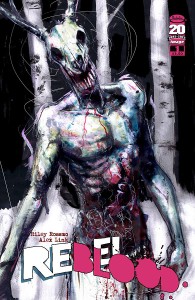 Most of the comics we read every week follow the tried-and-true method of showing events in a chronological manner. As we move from one scene to another, it’s assumed that every following sequence is further ahead in time. That’s why flashbacks – the most recurrent occurrence of breaking this rule – require special artifices to make them appear as outside the normal flow of time: captions, special panel borders, washed-out coloring and so on.
Most of the comics we read every week follow the tried-and-true method of showing events in a chronological manner. As we move from one scene to another, it’s assumed that every following sequence is further ahead in time. That’s why flashbacks – the most recurrent occurrence of breaking this rule – require special artifices to make them appear as outside the normal flow of time: captions, special panel borders, washed-out coloring and so on.
Alex Link and Riley Rossmo push the envelope on playing with time flow. Not only do they show scenes that don’t follow normal chronology, they show scenes that never actually happened – nor ever will! What they do is use the visual shortcuts associated with flashbacks and use them to show us scenes that only happen inside the main character’s head.
But before we go any further, let’s meet Chuck. Chuck is a former fireman who is now manning a fire tower in the middle of the forest. In a flashback, we see that he lost his old job following an accident which is heavily implied he caused himself. Why? The authors don’t come out and say it but it appears that Chuck is going through some sort of life crisis bad enough to make jumping off a roof seem like a viable alternative. Isolating himself in the middle of the woods seems to be the ideal way of also getting away from his wife berating him for losing his job.
That goes to show us that Chuck is a runner. When there’s trouble, he runs. And this time, the trouble is zombies.
So right from the start we have a character with some complex inner machinery. What can you do with such a character? Well if you’re reaching for the usual tools, you’ll present him with dramatic situations that challenge his way of thinking and have him interacting with other characters in a manner that underlines his complex personality.
Or you could also do what Link and Rossmo did here and show your characterization through hypothetical scenes. Basically, we get to see what Chuck fantasizes will happen once he gets to where he left his wife and kid.
What’s interesting here is that we’re not really seeing Chuck as he is but rather as he sees himself – which might be even more eloquent. This isn’t your usual objective viewpoint with a dash of monologuing caption boxes; this is the notion of unreliable narrator at its fullest since we get to literally see inside the character’s head. And it gets increasingly dark in there as Chuck’s thoughts turn from failure
to new beginnings
to finally revenge fantasies.
You know what this is essentially doing? It gets rid of all of the inner monologue captions and replaces them with actual scenes, actively engaging us in the flow of the narrative instead of having us sit back and swallow everything.
Now you didn’t think this was going to be me writing all this and you just sitting back, were you? No! I’m going to have pop quizzes! Now can someone tell me what were the visual clues used here by the artist to denote that these sequences aren’t real?
Lesson Learned
You don’t have to stick to a strict chronological telling of events. You don’t even have to constrain yourself to things that actually happen for real. Hypothetical scenes are fair game, especially if you present them through the strongly biased viewpoint of one of your characters. That way, you can not only break out of the classic what happens next mold, but also gain a powerful tool for presenting some refined characterization. Just don’t forget to use obvious visual clues to denote the subjective and unreal nature of your hypothetical scenes!
HIT!
The multi-layered narration in Scott Snyder’s BATMAN #7
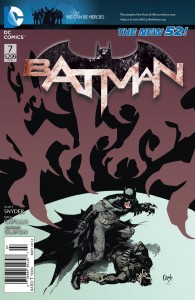 If you’re familiar with Scott Snyder’s writing, you’ll know he’s fond of starting with a few pages of heavy captioning. Just off the top of my head, I recall an interesting lecture in AMERICAN VAMPIRE about the deficiencies inherent to the teenaged personality, as well as a reflection on the importance of community in the opening pages of SEVERED #6. In both these cases, Snyder made sure the subject matter fit – ironically or not – with the action at hand in the panels where the captions appeared.
If you’re familiar with Scott Snyder’s writing, you’ll know he’s fond of starting with a few pages of heavy captioning. Just off the top of my head, I recall an interesting lecture in AMERICAN VAMPIRE about the deficiencies inherent to the teenaged personality, as well as a reflection on the importance of community in the opening pages of SEVERED #6. In both these cases, Snyder made sure the subject matter fit – ironically or not – with the action at hand in the panels where the captions appeared.
Quick! Name one more example of Scott Snyder doing this! And John Lees can’t answer this because he knows every Scott Snyder comic by heart!
You then find yourself with a commentary track that’s both entertaining and relevant without being redundant, like so many inner monologues can be.
In the case of BATMAN #7 however, he does something special: the captions don’t contain the hero’s thoughts or even an essay-like piece by a neutral narrator. Notice the quotation marks
Yup, this is dialogue, dialogue from characters who are nowhere in the present location, characters who might not even be speaking at the exact same moment in fact. But the important point here is that even though these lines are in a way designed to fit with another scene, they still apply perfectly to what we’re seeing on the present page.
Hence, Scott Snyder is writing for two different scenes at the same time:
- The primary scene is the one that’s not shown at the moment. It’s the leader of the Court of Owls speaking to their newest batch of Talons before sending them out to conquer Gotham City. At base level, these captions are referring to the process a Talon must go through before being reactivated .
- The secondary scene is the one shown: a dream sequence of an alternate interpretation of Batman’s origin myth. Bruce Wayne has just chosen to become the Caped Crusader instead of bleeding to death in his living room. In this second level, the text drives home the realization that has dawned upon Batman in the last few issues that the Court of Owls has always been there, long before his pointy-eared persona was ever invented. Hence, as Batman teeters on the brink of death in reality, this last dream reveals the horrible truth about his crusade: that he never truly was in control of anything and that the Owls had their talons sunk deep since the very beginning.
But these captions strike the hardest at the end of the following scene
The same way a Talon raises ever stronger from every defeat, Batman is now called to readjust his worldview and emerge even more powerful from his recent undoing. Thus Snyder takes it up one more level, above the immediate narrative and into commenting the new status quo of the BATMAN series itself.
Not only that but the fact of having the same text applying to both Batman and the Court of Owls’ army of killers draws an interesting parallel between these characters, showing in words how similar they can be, and then contrast how different they are with their actions.
Lesson Learned
Narration in caption boxes can be made to have more emotional impact if you take care of giving them at least two separate yet relevant meanings. To accomplish this, you need one primary scene with some running dialogue that you will layer onto another secondary scene with caption boxes. The two scenes don’t have to be simultaneous. What’s important is that the text applies to both presented situations. More often than not, this relevance will be purely figurative in the case of the secondary scene. Be careful not to write dialogue that’s too specific to your primary scene or you won’t have enough leeway to make it stick to the secondary one. If you can insert even more layers of meaning in there, more power to you, but aim for two layers only if you want to be sure to pull this trick off. We can’t all be Scott Snyder after all!
MISS
The lack of structure of Selwyn Sefu Hinds’ DOMINIQUE LAVEAU: VOODOO CHILD #1
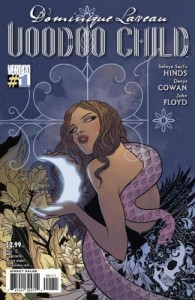 They say you only get one chance at making a good first impression. That goes doubly for comics when a bad impression usually means no second impression. (As in printing. See what I did there? OK, forget it.) Anyway, it’s always a sad sight to see a new series stumble at issue 1.
They say you only get one chance at making a good first impression. That goes doubly for comics when a bad impression usually means no second impression. (As in printing. See what I did there? OK, forget it.) Anyway, it’s always a sad sight to see a new series stumble at issue 1.
DOMINIQUE LAVEAU: VOODOO CHILD#1 (henceforth referred to as DLVC #1) suffers from a bad case of meandering storytelling. To say it in colloquial terms, it’s all over the damn place and back again. Like its sweatshirted heroine, the plot spends most of this issue running around town, barely stopping to catch its breath and being tossed and threatened at every turn. It’s a rough ride and the reader no doubt feels the same way as Dominique does after turning the last page.
Let’s break down the sequence of events that make up DLVC #1
- Dominique is running through New Orleans pursued by a werewolf and caption boxes. She defeats the werewolf in a way that’s not entirely clear (magic snakes?).
- Dominique runs into a policeman friend. Their conversation (“My friends re dead!”) is interrupted by two gang members shooting at them. While the cop shoots back, Dominique runs away.
- Down in the French Quarter, a creepy guy gets a boy possessed by a Voodoo… god? Anyway, creepy gets ordered to find Dominique on the double. That tells me she’ll probably have to run.
- Back to Dominique running through a cemetery – because that’s certainly the first place you think to go to when you’ve just been chased by an extra from a Universal horror movie. She somehow gets transported to the Voodoo Queen’s court where – as an unseen presence – she discovers all members of the Court and the Queen herself dead. She’ spotted by a guy who has been seemingly following her since the start of the comic – running, no doubt. She escapes him and utters the strangely empathetic line: “What the hell was that?”
- Dominique runs home to find her aunt dying from… a profuse nose bleed – it’s not really clear but she did leave a big stain on the carpet. She’s then cornered by the guy who was tailing her and he goes all 90s glamour in the last splash page.
Notice a trend? Apart from all the running, I mean? No, you don’t and that’s because there isn’t any.
Every part of this plot follows the other in a way that denotes no causality between them. Why is there a werewolf pursuing Dominique? We don’t know. Who were Dominique’s friends who were killed? We don’t know. Why are gang members shooting at her and her cop friend? We don’t know. Why is the creepy guy looking for Dominique? We don’t know. Why has the Voodoo Queen’s court been assassinated? We don’t know. Who is this guy who keeps following her? We don’t know.
But most importantly, why do any of these things happen in this order? Everybody now: WE DON’T KNOW.
That’s because DLVC #1 is made up of nothing but beginnings. Dominique is introduced. The being-chased-by-monsters is introduced. Her “power” is introduced. The cop friend is introduced. The murdered Court is introduced. The blond shuriken-throwing guy is introduced. The creepy god-summoning guy is introduced. The murder of Dominique’s aunt is introduced. Yet nothing is ever dwelled upon but very superficially before we run off somewhere else.
This isn’t a first issue; it’s a table of contents.
If you had to expound on one of the plot points in this first issue, what would you choose?
Lesson Learned
It’s OK to introduce elements to your story and then wait a few pages – or even issues – before explaining them. That’s what suspense, cliffhangers and big revelations are all about. However, if you overdo it and fill your comic with nothing but teasers, you won’t be giving your reader any reason to come back. You need substance – you need meat! – between each new element to keep your reader interested and emotionally invested in your story. Don’t let your comic be nothing but an enigma to your reader!
Honorable mentions
- There’s some fantastic world-building done in Mike Costa and Jon Armstrong’s SMOKE AND MIRRORS #1. This is what happens when you grab onto a concept and follow it through in all its logical extremities.
- Mark Millar’s SUPERCROOKS #1 subverted the whole scheme of classic hero and villain characterization by successfully inverting who you should actually root for.
Dishonorable mention
- Brian Azarello seems to forget he’s writing an ongoing title this week as his WONDER WOMAN #7 ends flatly with the resolution of a situation that had no detectable weight in the grand scheme of things. Since the reader is left with no motivation to come back the next month, this created the perfect drop-off point for anyone who had doubts about the series.
That’s all for this week, folks! I hope you had as great a time reading this as I had writing it. Got any questions, comments or hankering for ice cream? Sound off right below!
Oh and by the way, don’t mind the logo too much: it’s a mock-up I did in PowerPoint. The real one is coming soon and we got a real pro working on it!
Related Posts:
Category: Columns, Points Of Impact


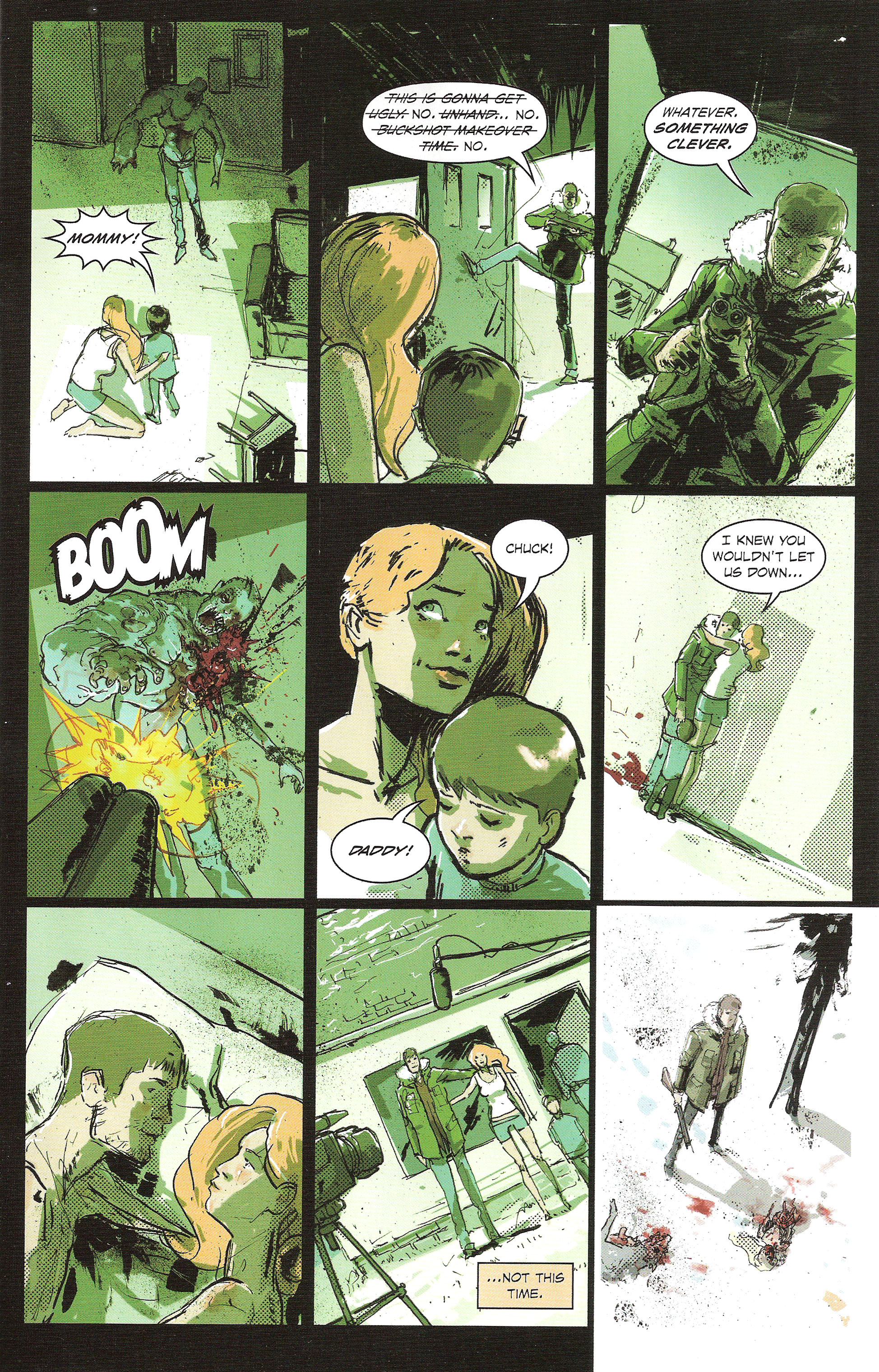
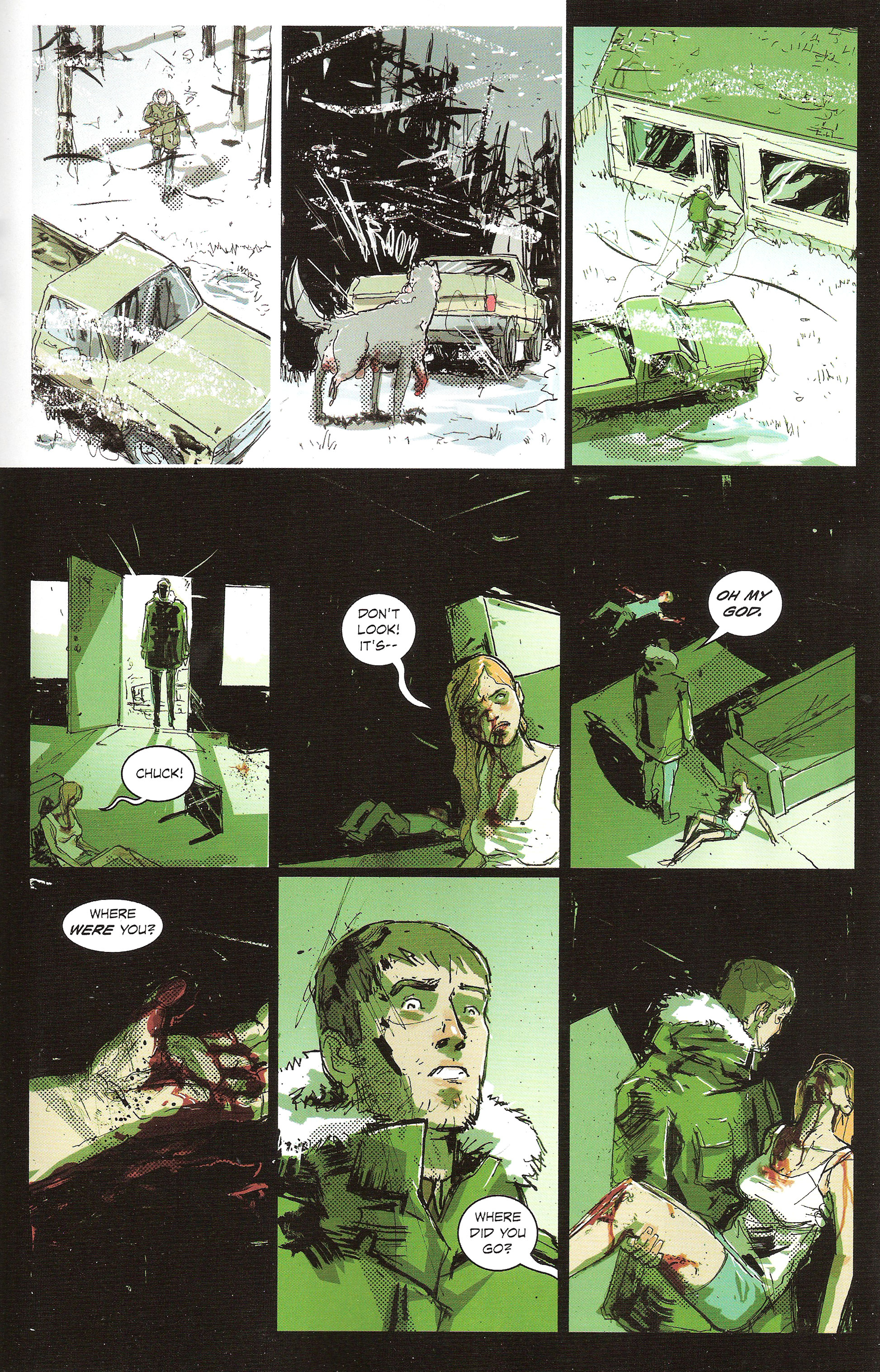
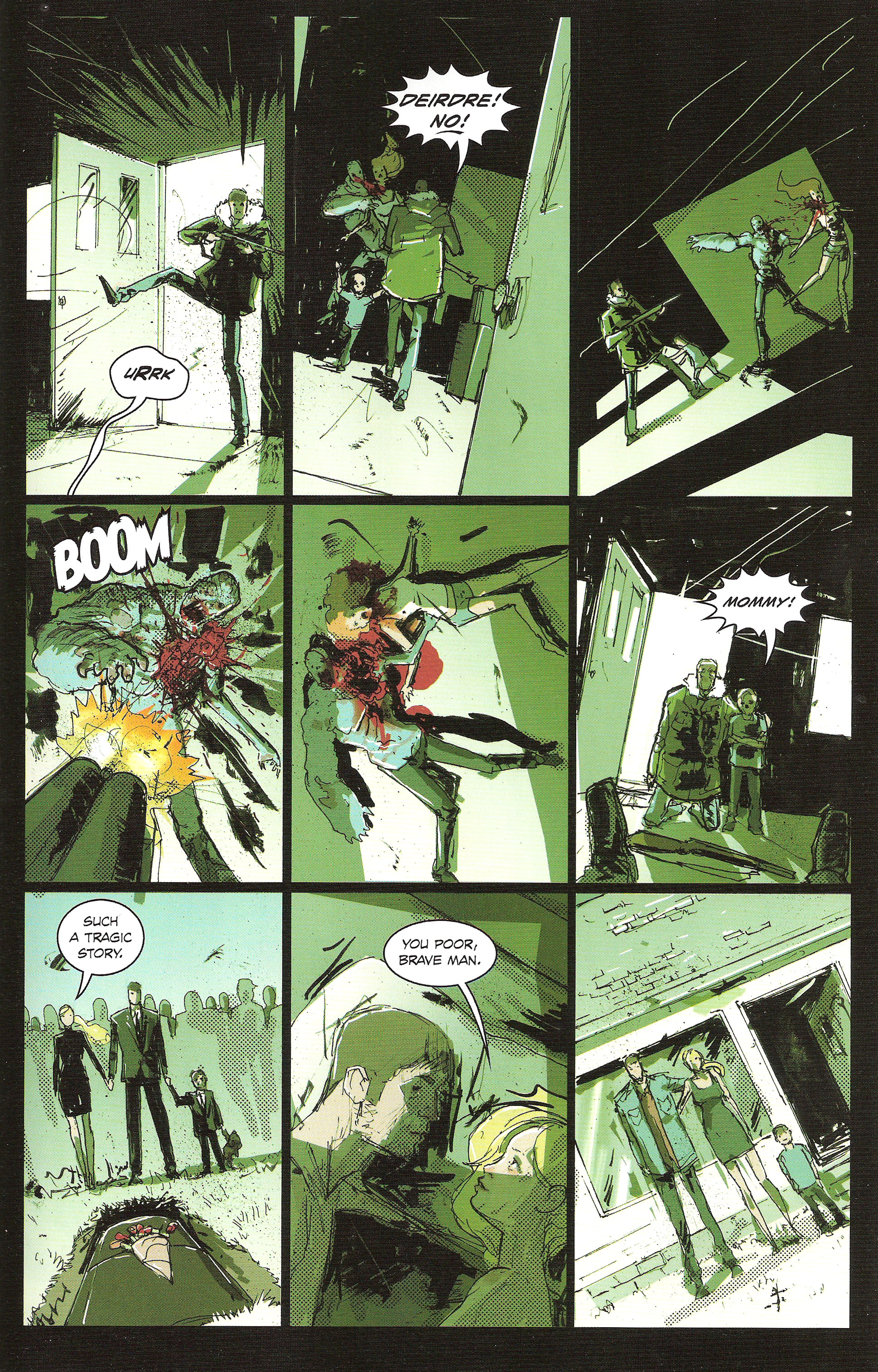
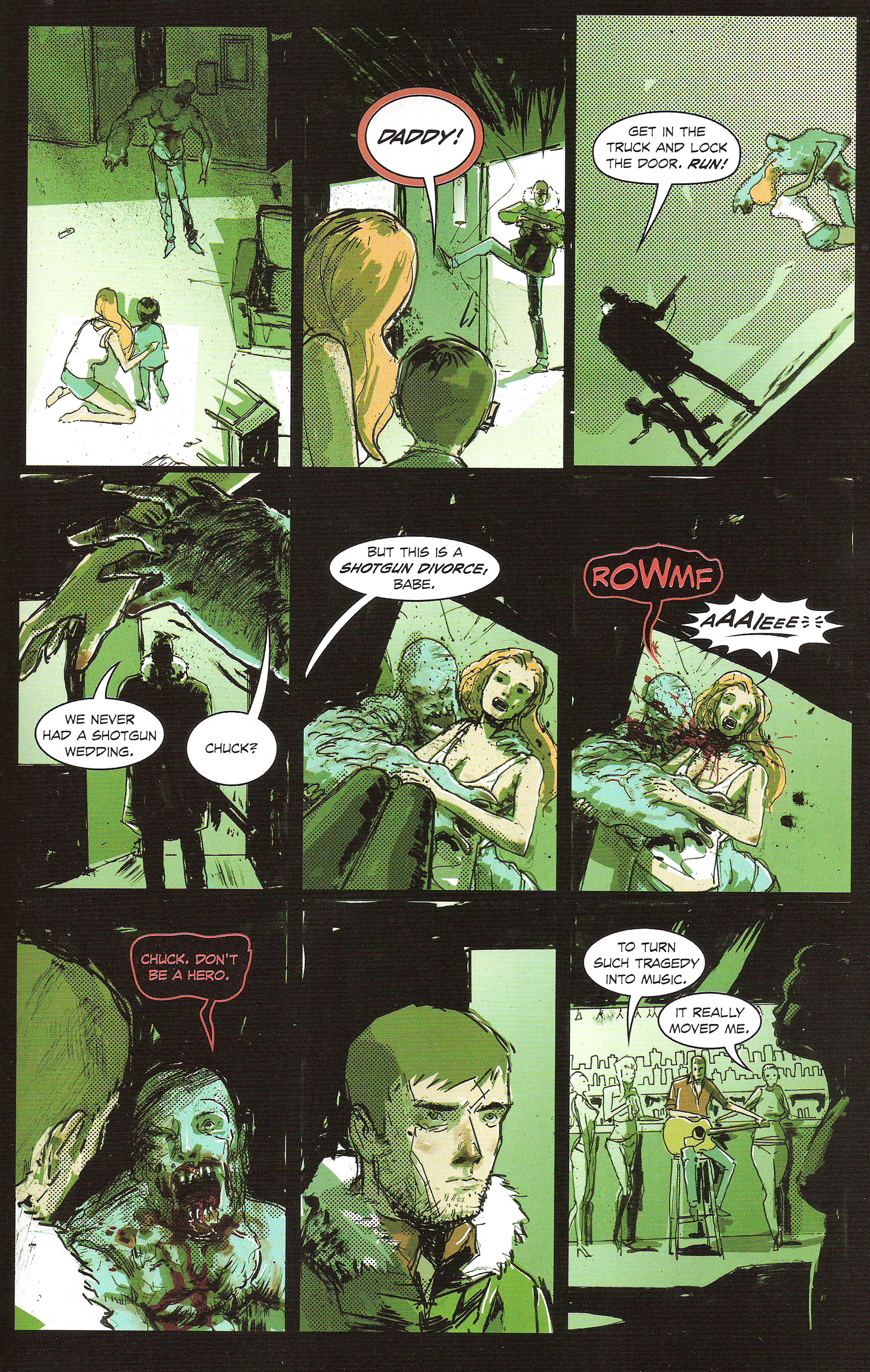
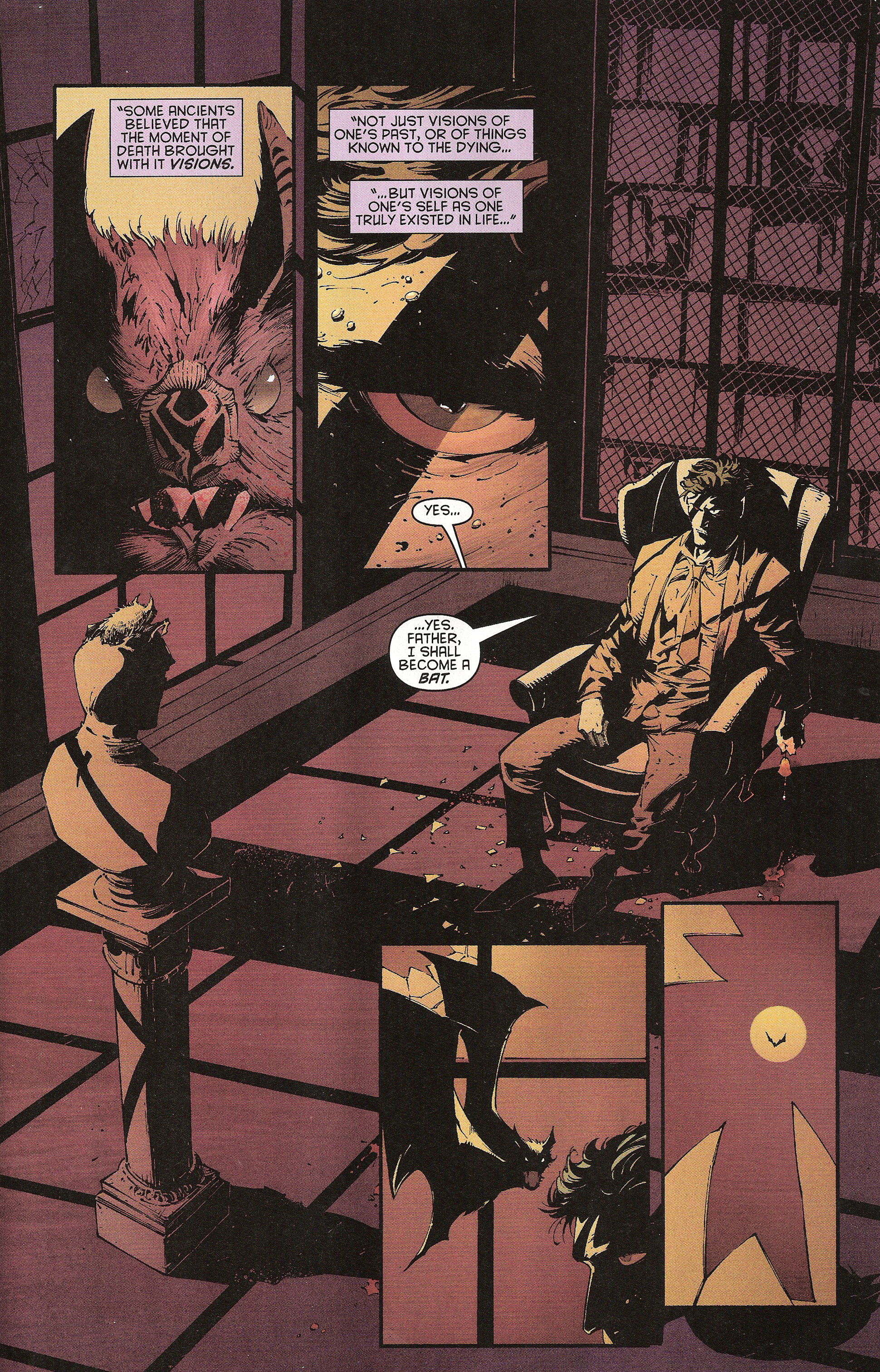
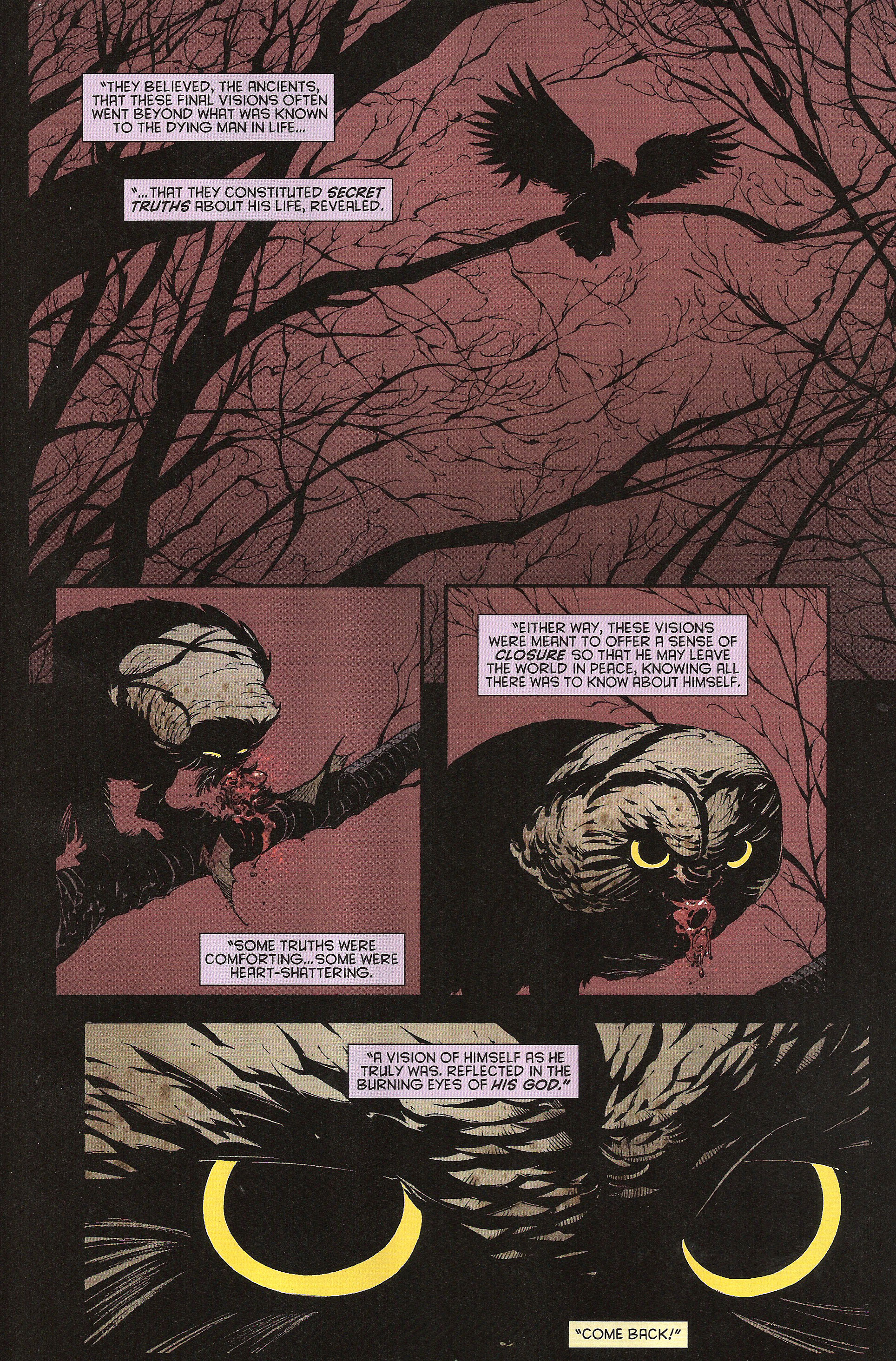

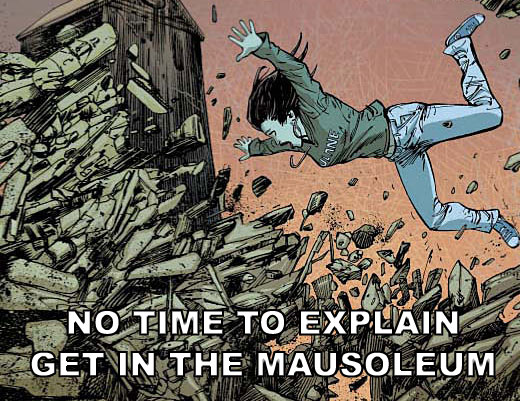
















I say this with no inside knowledge of the book (as Shadowline’s communications guru) but through my own reading of REBEL BLOOD #1 — the visual clues that the scenes are taking place in Chuck’s head are the black borders around those scenes. Anything taking place in ‘normal time’ have white borders. At least that’s what I noticed and that’s the theory I’m going with.
Halfway there!
Yes, the panel borders are ONE of the indicators that these scenes aren’t real. There’s still one other thing. I’m gonna let somebody else try before I give the answer.
And no asking Riley, Marc! 😉
I’m Image Comics PR & Marketing person, but I also have no inside knowledge regarding this question, so —
The black borders, the green tint, and the revised dialogue in the first scenario are the clues that the scenes are imaginary.
I’m kind of surprised at the number of reviewers who didn’t pick up this and instead refer to these scenes as “flashbacks” (hunh?).
Thanks for your analysis, Yannick! We really appreciate it! I’m looking forward to more Points of Impact columns. I’m a big lover of craft, and and more focus on it in the comics review world is very welcome!
Right you are, Jennifer! The dominant green tint in these panels is indeed a major visual cue about the unreal nature of the scenes in question. The black panel borders are another clue, as Marc pointed out.
I daresay you even went above and beyond the call of duty because you also noted cues in the text. Indeed, where else but in your imagination would you be able to edit your own dialogue lines and use placeholder text?
I’m glad you like the new column! Thank you! Here at ComixTribe, we’re always looking for new ways to help comic creators. Bringing Points of Impact here seemed like a step in the right direction, bridging the gap between learning the craft and enjoying your weekly comic haul.
Check back here Saturday for some more literary vivisection! And if you’re a fan of craft discussion, you might enjoy Steven Forbes’ columns, Bolts & Nuts which focuses on theory and the dreaded Proving Grounds, where aspiring writers put their fledgling scripts to the test!
I was going to say that the panels being green are one thing but the panels are setup in the same panel grid with the same scenario of the guy facing down the zombie. It reminded me of groundhog day
Good catch about the grid, Eli! I hadn’t even noticed myself! Yup, keeping the same page structure as a motif really helps driving in the point that nothing in this scene is real.
Interesting stuff they’ve done here. I wonder if anyone else wil pick up on it in the following months.
Thanks,Yannick. It’s a very subjective medium, so there’s all kinds of devices you can use in this medium. On a side note, I can see why you like Scott Synder. I just caught on some of my issues of Batman and that owls storyline is very thorough. That maze issue was nuts, I’ve never flipped a book around so many times. Very good storytelling. It’s a good sign to me when someone can make you feel like the hero really doesn’t have a shot and then when they pull it off it through some intelligent means and not just “They get really mad and throw one punch.”
Enjoying the article so far!
“It’s a good sign to me when someone can make you feel like the hero really doesn’t have a shot and then when they pull it off it through some intelligent means and not just They get really mad and throw one punch. ”
You bring up a very interesting point. One of the greatest challenges faced by comic writers is writing characters that are more intelligent than they are. Like you said, it’s easy to have your hero “hulking out” and busting out of a death trap; it’s another thing to have him outwit that same trap in a clever way that surprises your readers.
I had a Points of Impact a couple of weeks ago on my blog that had PETER PANZERFAUST #2 as an honorable mention for that exact same reason. In it, Peter and the boys need to free some British prisoners from a German outpost. They didn’t go in guns blazing. On the contrary, they came up with a plausible plan and acted upon it, even though one of their own came up with a potentially lethal improvisation.
In my opinion, that was a mark of great cunning creativity from Kurtis J. Wiebe.
I’ve been reading some of your blogs. I see you’re a fan of wiebe(I may start checking some of his stuff out) Nathan Edmunson, I have read some of his stuff. He did some good work on who is jake ellis, I haven’t read any of his the activity work yet. But I’ve read that he has a navy seal advisor helping him out as well. I wonder if these writers just watched a lot of macgyver as children.
Kurtis J. Wiebe and Nathan Edmondson are part of a group of writers I like to describe as “cerebral”. Whenever you read their comics, you can always see there’s a good deal of attention given to craft and technique. As such, they create works that are very valuable to anyone serious about learning from their reading.
Ed Brubaker’s Sleeper is a really good example of subtle storytelling. It was a little caption heavy for me at first. It had a good take on super powered criminals, without making it over the top and exploring more on character development. I like his take on caption america as well. I think he’s got an issue coming up with criminals in witness protection being hunted by some mystery man. So he’s good at balancing on the action/suspense border. There’s a lot of good stuff out there and a lot to learn.
I’m a big fan of what Brubaker does outside of the superhero genre. His CRIMINAL stories are mandatory reading for anyone interested in noir comics. I’ve been particularly taken in by his recent FATALE as well.